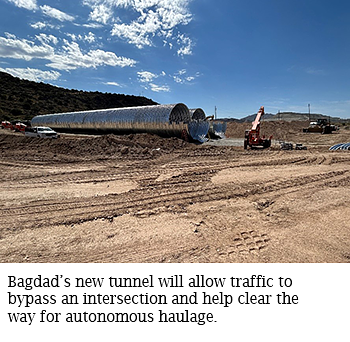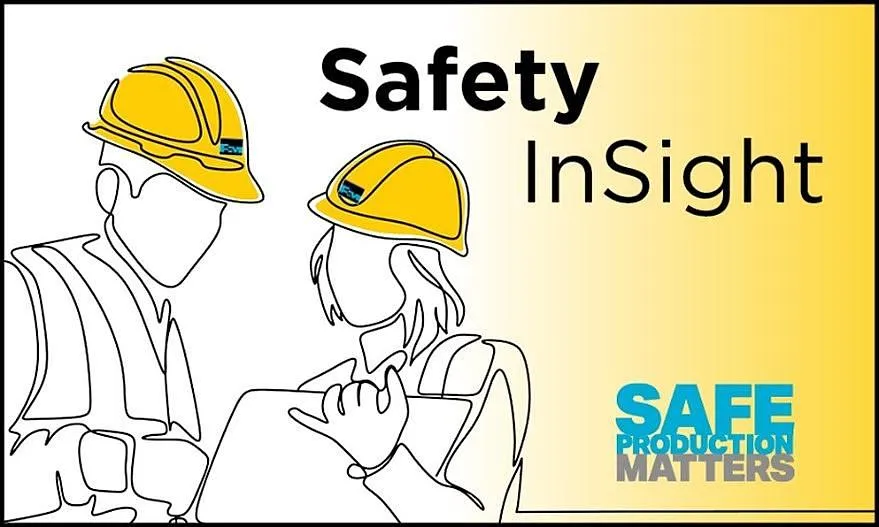 Bagdad is paving a new path forward for both mine haulage and vehicle safety as the site nears completion of a bypass tunnel that will segregate light vehicle traffic from its autonomous haul trucks.
Bagdad is paving a new path forward for both mine haulage and vehicle safety as the site nears completion of a bypass tunnel that will segregate light vehicle traffic from its autonomous haul trucks.
Set to open later this year, the nearly 300-foot tunnel is one of several major infrastructure projects needed to bring Bagdad’s upcoming autonomous haulage fleet online in 2025. According to Jacob Miyauchi, Civil Engineer II-Bagdad, those preparations allow the site to achieve multiple safety goals simultaneously, engineering safety solutions into the conversion.
Traditionally, Bagdad has used gates and other safety measures to mitigate vehicle collision risks, but there remained the potential for vehicles to encounter haul trucks when venturing beyond the intersection.
“While we’ve been fortunate so far, there’s always an inherent risk with haul road intersections,” Miyauchi said. “The long-term planning involved with autonomous haulage allowed us to address those risks in a way that made mitigation more feasible.”
Given the track record of autonomous haulage at other international mining operations, the company already is anticipating their introduction will improve safety performance by minimizing human presence in hazardous areas, using sensors to detect and avoid obstacles, and maintaining consistent and controlled vehicle operations.
These built-in safety measures mean autonomous trucks automatically will slow down or even completely stop, depending on road conditions. Provided it is safe to continue work with other trucks and equipment, the tunnel, constructed of a series of corrugated panels that will be buried underneath the haul road, would allow other vehicles to bypass stopped haul trucks.
Rachel Adams, Health and Safety Manager-Bagdad, views this conversion and the supporting infrastructure as a good test case, providing an opportunity to see how effectively permanent safety solutions can be incorporated into something as fluid as mine planning.
“These types of forward-looking solutions are exactly what we need to keep workers out of harm’s way and keep trucks moving,” Adams said. “It is a win-win situation, as the company’s priority always has been – and always will be – safe production.”
 Vehicle collisions remain a serious roadblock
Vehicle collisions remain a serious roadblock
Even as it begins to implement some solutions, the company continues to grapple with a high number of vehicle-related safety incidents.
Earlier this year, an accident in New Mexico underscored the seriousness of that concern, when a haul truck rolled over the hood of a pickup truck with its rear tires as the pickup proceeded into the intersection at the same time as the haul truck.
While no one was injured, it was mere inches and seconds that prevented it from being a tragic event.
An investigation found that one of the major contributing factors was a failure to yield due to poor road design. The site took immediate action, auditing its berm heights to ensure visibility for light vehicles and installing a roundabout to slow traffic at the intersection.
However, the prevention of future vehicle accidents largely depends upon one key factor -- the employees themselves.
Adams, who has worked at multiple mines during her career with Freeport, recognizes that not every site has the luxury of segregating its haul trucks from light vehicles like Bagdad is doing. Instead, continued safety relies upon employees using critical controls, following procedures, using warning systems and recognizing hazards, like berm heights that limit visibility.
“What we have at Bagdad is a unique opportunity to see the ideal scenario play out,” Adams said. “But at the end of the day, the best safety measure is always going to be good judgement and adequate critical controls.”
